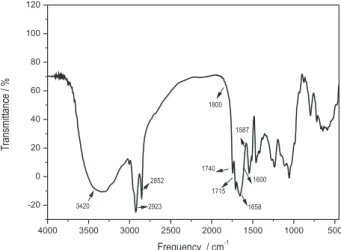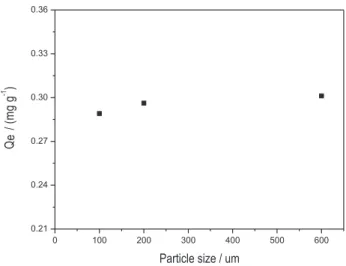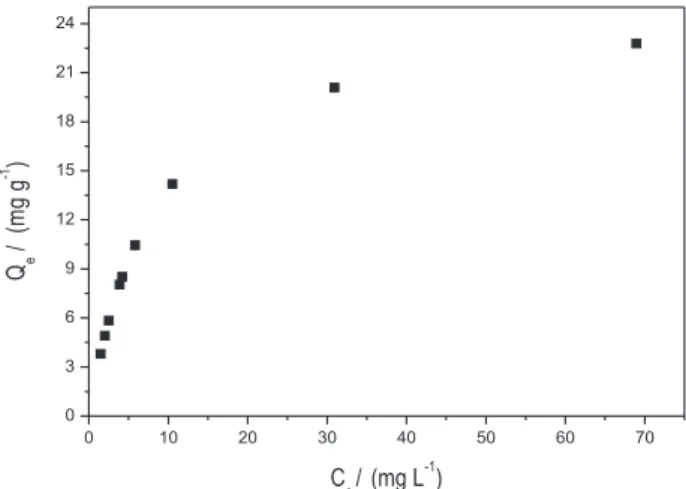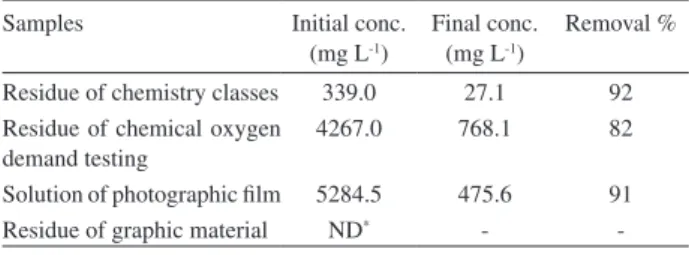Ar
ti
cle
*e-mail: nmmcoelho@ufu.br
Moringa oleifera
Lam. Seeds as a Natural Solid Adsorbent for Removal of Ag
Iin Aqueous Solutions
Cleide S. T. Araújo, Edmar I. Melo, Vanessa N. Alves and Nívia M. M. Coelho*
Instituto de Química, Universidade Federal de Uberlândia, Av. João Naves de Ávila 2121, 38400-902 Uberlândia-MG, Brazil
Este trabalho descreve o potencial de sorção das sementes de Moringa oleifera para descontaminação de AgI em soluções aquosas. Espectroscopia de infravermelho foi usada para
elucidação de possíveis grupos funcionais responsáveis pela adsorção de AgI. Estudos de adsorção
foram feitos em batelada usando soluções padrão de AgI como função da massa do adsorvente,
tempo de extração, tamanho da partícula e pH. A AgI foi quantiicada antes e após os experimentos
de remoção usando espectrometria de absorção atômica por chama. Adicionalmente, considerando-se os estudos de adsorção e isotermas de adsorção aplicadas ao modelo de Langmuir foi possível veriicar que as sementes de M. oleifera apresentam alta capacidade de adsorção. As condições ótimas foram: 2,0g de adsorvente com tamanhos de partícula de 75-500 μm, 100 mL de solução 25,0 mg L-1 AgI, tempo de extração de 20 min e pH 6,5. Os resultados mostram que as sementes
de Moringa oleifera podem ser usadas para remoção de AgI em soluções aquosas.
This work describes the sorption potential of Moringa oleifera seeds for the decontamination of AgI in aqueous solutions. Infrared spectroscopy was used for elucidating possible functional
groups responsible for uptaking AgI. Sorption studies using AgI standard solutions were carried
out in batch experiments as functions of adsorbent mass, extraction time, particle size and pH. The AgI was quantiied before and after the removal experiments using lame atomic absorption
spectrometry. Furthermore, based on adsorption studies and adsorption isotherms applied to the Langmuir model, it was possible to verify that M. oleifera seeds present a high adsorption capacity. The optimum conditions were: 2.0 g of adsorbent with particle size of 75-500 μm, 100 mL of 25.0 mg L-1 AgI, extraction time of 20 min and pH at 6.5. The results show that Moringa oleifera
seeds can be used for removing AgI in aqueous solutions.
Keywords: removal, characterization, sorption, Moringa oleifera, silver
Introduction
Industrial processes have historically been an important factor of environmental degradation. The disposal of industrial wastes, mainly containing metal ions in water sources represents a problem of great concern not only in relation to biota in the receiving environment, but also to humans. Silver is included among the main pollutants because of its high toxicity.1,2 Therefore methods to
minimize pollution caused by this metal are attractive. Conventional techniques used for removing metal ions include iltration, precipitation, locculation, ion exchange resins and reverse osmosis.3 However, these technologies
have limitations such as high operating cost, incomplete
removal of metal ions and generation of toxic sludge.4-6
On the other hand, the biosorption process offers several advantages such as low cost of the biosorbent, high eficiency, minimization of chemical and/or biological sludge and regeneration of biosorbent.7
In this way, natural adsorbents constitute an excellent alternative for chemical remediation of heavy metals from aqueous solutions.8-10
Microorganisms such as algae, yeast, bacteria and fungi have been widely evaluated as biosorbents for removing metal ions from an aqueous solution.11-13 However,
biosorption of metal ions onto microorganisms is affected by several factors such as pH, metal concentration, biomass loading, temperature and other parameters.
for metal ions adsorption due to the characteristics of the functional groups present in these materials.14
Recently, natural adsorbents have been proposed for removing metal ions due to their good adsorption capacity.1 In this context, the Moringa oleifera seeds
present themselves as an alternative material for this propose.15,16
M. oleifera seeds have been used for treating turbid water due to their locculating properties. A locculating protein from M. oleifera Lam. seeds was isolated by Gassenschmidt et al. (1995).17 The molecular protein mass
was determined at about 6.5 kDa, the isoelectric point was above pH 10. Flocculation activity could be explained by the patch charge mechanism due to low molecular weight and high charge density.
The present work describes the sorption potential of M. oleifera seeds for decontamination of AgI in aqueous
solutions. Variables such as particle size, pH, extraction time and sorbent mass were evaluated. The proposed adsorbent was applied to efluent samples.
Experimental
Sorbent preparation
The M. oleifera seeds were obtained from trees which were cultivated in the city of Uberlandia (Minas Gerais, Brazil) and collected from September-November 2007. The seeds were separated from the pods, crushed in a household blender (Black & Decker, São Paulo, Brazil) and strained through 500, 180 and 75 μm sieves.
The functional groups present in M. oleifera were characterized by Fourier transform infrared (FT-IR) spectrometer (Shimadzu, IRPrestige-21, Tokyo, Japan). The spectral range varied between 4000 to 500 cm-1, with
twenty eight scans in a resolution of 4 cm-1.
Sorption studies
Removal studies using standard AgI solutions were
carried out in triplicate. The seeds were shaken with 50 of 25 mg L-1 AgI for 20 min using a magnetic agitator and then
the suspension was iltered using ilter paper (Whatman 42,28 μm). AgI was quantiied before and after the removal
experiments.
In order to obtain the optimum condition for the percentage of AgI removal, the following variables were
studied: particle size of the sorbent (500, 180 and 75 μm), pH (2.0, 4.0, 6.0 and 8.0), extraction time (5, 20, 35 and 50 min) and sorbent mass (0.1, 0.2, 0.3, 0.4, 1.0, 2.0, 3.0 and 4.0 g). The eficiency of the removal was evaluated
from the Qe (uptake of metal per unit weight of sorbent) obtained by the equation 1:16
(1)
where Ci (mg L-1) is the AgI initial concentration,
Cf (mg L-1) is the AgI inal or equilibrium concentration,
V (L) is the volume of the test solution and m (g) is the sorbent mass.
Isotherm adsorption
The experiments were carried out at a temperature range of between 25and 28 oC, using 50.0 mg of non-shelled
M. oleifera seeds (500 μm) and 50 mL of AgI solution in
a concentration of 5 to 100 mg L-1. The pH of the mixture
was adjusted at 6.5 using 0.5 mol L-1 NaOH and extraction
time was 20 min. The mixture was iltrated and the AgI was
quantiied using lame atomic absorption spectrometry.
AgI determination
Standard solutions of AgI were prepared from
1000 mg L-1 AgI (Carlo Erba, Val de Reuil, France).
The AgI was quantified using an atomic absorption
spectrometer (SpectrAA-220 Varian, Victoria, Australia). Instrumental conditions such as wavelength of 328.3 nm, slit of 0.1 nm, current lamp of 4.0 mA, air low rate of 13.5 L min-1 and acetylene low rate of 2.0 L min-1 were
used.
Studies of interferent ions on the removal of AgI
The removal of AgI in the presence of PbII, CuII, CdII and
CoII, in various proportions, denominated by concomitant
ions, was evaluated using non-shelled M. oleifera seeds. The experimental conditions were: particle size of 500 μm, extraction time of 20 min, sorbent mass of 2.0 g and pH of 6.5.
Application of the proposed method
The proposed sorbent was applied to residue obtained from chemistry classes, residue tested for chemical oxygen demand in this institution; film developing solution and residue from graphic material, obtained from local businesses. These efluents contained AgI, PbII, CuII, CdII and
CoII ions. Samples were iltered through ilter paper and the
pH adjusted at 6.5, using 0.5 mol L-1 NaOH. One hundred
M. oleifera seeds for 20 min AgI was quantiied using FAAS
before and after removal experiments.
Results and Discussion
Biosorbent characterization
The main functional groups present in the M. oleifera seeds were characterized by infrared material analysis. The broadband centered at 3420 cm-1 can be attributed
to O−H stretching of the connection in this protein, fatty acids, carbohydrates and the lignin units. Due to the seed high protein content there is also a relevant contribution to this region because of N–H stretching in the bondage of amides.18 The peaks that appear in 2923 and 2852 cm-1
correspond respectively to the asymmetric and symmetric stretching of the connection of the C–H in CH2 group. Due to the high intensity of these bands it is possible to assign them to the predominantly lipid component of the seed that is present in high proportion similar to the proportion of the protein.19 In the 1800 to 1500 cm-1 region there are a
number of overlapping bands between 1750 and 1630 cm-1.
This set can be attributed to the C=O connection stretching. Owing to the heterogeneous type of seed, the carbonyl group may be linked to different neighborhoods as part of the fatty acid portion of lipid and protein portion of the amides. The carbonyl that appears due to the lipid component in 1740 and 1715 cm-1, which can be observed
in the spectrum as a small peak or shoulder part of the main band at 1658 cm-1, was assigned to the carbonyl amides in
the protein portion. The peak at 1587 cm-1 can be attributed
to the stretching of the C–N linkage and the deformation of the N–H linking proteins present in the seed jug. Literature reports that M. oleifera Lam. seeds present a protein mass composition of 29.36%. 20 Figure 1 presents the seeds
infrared spectrum.
Studies of sorption variables
Figure 2 shows Qe values in the function of sorbent mass for non-shelled and shelled seeds and husk using 5.0 mg L-1 AgI. It was observed that husks showed more
eficiency for AgI removal than non-shelled and shelled
seeds for quantities of 50 mg of sorbent or less. However, in quantities of sorbent above 50 mg, differences were not observed between non-shelled and shelled seeds and husk. Signiicant differences were not observed for the test-F with a 95% assurance. Therefore, non-shelled seeds were used for further studies.
The following variables were studied: particle size of sorbent, pH, time of extraction, sorbent mass, metal concentration and volume of AgI solution.
Qe values in function of the adsorbent particle size (500, 180 and 75 μm) were obtained (Figure 3). A decrease in particle size showed a favorable effect on metal sorption justiied by an increase in the adsorbent surface area. However, particle sizes of 180 and 75 μm were not used because the filtration step was very slow. Moreover, Qe values were similar, i.e., 0.289 and 0.301 mg g-1
for ≤ 500 μm and ≤ 75 μm, respectively.
The effect of pH range on AgI adsorption was studied
from 2.0 to 8.0 (Figure 4). The conditions were: 500 μm particle size, 20 min extraction time, 4.0 g adsorbent mass and 50 mL of 25.0 mg L-1 AgI. Optimum values of
Qe were obtained in pH > 4.0; above this Qe values were found constant.
Biosorbent materials primarily contain weak acidic and basic functional groups. This is in accordance to the acid-base equilibria theory, in the 2.5-5 pH range, the binding of heavy metal cations is primarily determined by the Figure 1. FT-IR spectrum of Moringa oleifera seeds.
Figure 2. Capacity of sorption of the Moringa oleifera seeds in the AgI removal. Experimental conditions: Extraction time = 5 min; pH = 6.5; Volume of AgI = 25.0 mL; Concentration of AgI = 5.0 mg L-1.
state of dissociation of the weak acidic groups. Carboxyl groups (–COOH) are the important groups for metal uptake by biological materials.16 The ionic states of cell wall
functional groups can be used to explain the pH dependence of biosorption. Low pH conditions allow hydrogen and hydronium ions to compete with metal binding sites on the biomass, causing a poor uptake. At higher pH values, 5-7, there is a lower number of competing hydrogen ions and more ligands are exposed with negative charges, resulting in greater sorption. Whereas at a pH > 7, it occurs the solution precipitation, leading to a reduction sorption capacity.16
These results are in accordance with literature. Therefore, the 6.5 pH value was then chosen for further studies.
The effect of extraction time on AgI sorption was
studied in the 5 to 50 min range. Figure 5 shows that the amount of silver ions retained by the adsorbent material
increased considerably for up to 20 min and was constant after that. The time of 20 min was chosen due to the good results presented in the removal (Qe = 0.302 mg g-1) and
the shortest time for sorption process.
Figure 6 shows the removal studies made using 25 mg L-1 AgI and non-shelled M. oleifera seeds from
0.1 to 4.0 g. The results show that the uptake of quantity of adsorbed metal per unit weight of sorbent decreases suddenly until 1.0 g of M. oleifera, indicating an increase in the AgI removal. In the 1.0 to 4.0 g interval, the Qe values
remained constant probably due to the equilibrium reached.
Isotherm adsorption
One of the important physicochemical aspects for the sorption process evaluation is the equilibrium of sorption. Figure 3. AgI removal in the function of the particle size. Experimental
conditions: Extraction time = 20 min; Moringa oleifera mass = 4.0 g.; Volume of AgI = 50.0 mL; pH = 6.5; Concentration of AgI = 25.0 mgL-1.
Figure 4. AgI removal in the function of the pH. Experimental conditions: particle size = 500 μm; Extraction time = 20 min; Moringa
oleifera mass = 4.0 g.; Volume of AgI = 50.0 mL; Concentration of
AgI = 25.0 mg L-1.
Figure 5. Capacity of sorption of the Moringa oleifera in the function of extraction time. Experimental conditions: particle size = 500 μm; Moringa
oleifera mass = 4.0 g.; Volume of AgI = 50.0 mL; pH = 6.5; Concentration
of AgI = 25.0 mg L-1.
Figure 7 shows the isotherm sorption of AgI on non-shelled
M. oleifera seeds.
The isotherm curve obtained indicates favorable adsorption process and highlights the strong tendency of the process for monolayer formation. Therefore, the extent of sorption was adequate to the Langmuir model. The Langmuir equation assumes that adsorption is limited to the monolayer and a maximum adsorption indicates saturation of this monolayer. The experimental results obtained were plotted (correlation coeficient of 0.99352) in Langmuir isotherm linear equation from 5 to 100 mg L-1 AgI
(Figure 7). The plot of Ce/Qe versus Ce gives a straight line of slope 1/Qmax and intercept 1/Qmaxb. The magnitude with Langmuir Qmax and b constants show adsorption capacity of 23.13 mg of AgI per gram of non- shelled M.
oleifera seeds and adsorption energy of 0.1586 L mg-1,
respectively.
Comparison of the present study with other adsorbents
The present study showed that Moringa oleifera seeds demonstrated good removal capacities for AgI
(23.13 mg g-1) as compared to the reports with other adsorbents
(Table 1).
Studies of interferent ions in the removing of AgI
Removing of AgI in the presence of PbII, CuII, CdII
and CoII ions was studied in the following conditions:
500 μm particle size, 20 min extraction time, 2.0 g adsorbent mass, 6.5 pH and 100 mL AgI volume. The
results are shown in Table 2. The inluence of interferents was veriied by comparing the percentages of removal of a solution containing only AgI and a solution containing
AgI ions and interferent ion. Removal percentage was
calculated based on analytical signals obtained before and after the removal procedure and the tests performed in triplicate.
In this study, a specie is considered as interferent for the removal of AgI in the proposed procedure, when the
difference between the values of removal of the solution containing only ions AgI and those containing the possible
interfering ions is more than 10%.25
Thus, the interference factor, IF, is defined by equation 2:
IF = A′/ A (2)
where A′ is the value of the percentage of removal on the solution of AgI in the presence of possible interference,
and A is the percentage of removal on the solution of Ag I
in the absence of possible interference.
In this case, IF = 1.00 means that there is no interference, while factors greater than 1.10 or smaller than 0.90 indicate an increase or a decrease of analytical signal due to interference.
Table 3 shows the results of removal of AgI in real
samples. The values obtained satisfactory confirm the excellent potential for removal of ions AgI using
M. oleifera Lam seeds. The methodology is simple, low cost and can therefore be used in remediation techniques.
Figure 7. Adsorption isotherm for AgI by Moringa oleifera seeds. Experimental conditions: size of particle = 500 μm; pH = 6.5; Concentration of AgI = 5.0 at 100 mg L-1; Extraction time = 20 min;
Moringa oleifera mass = 50 mg. (A).
Table 1. Comparison with other adsorbents
Absorbent Maximum adsorption
capacity (mg g-1)
Reference
Resin Amberlite XAD-16 4.66 21
Modiied silica gel using 2,4,6-trimorpholino-1,3,5-triazin 0.384 22
Naphitalene modiied with dithizone 0.029 23
Octadecil silica membrane disks modiied by (CBT) 0.214 24
M. oleifera seeds 23.13 This work
Table 2. Effect of interferent ions on the removal of AgI. Experimental conditions: Particle size = 500 μm, extraction time = 20 min, mass of adsorbent = 2.0 g, pH 6.5
Proportion analyte: interferent
Removal % of Ag I
Interference Factor (IF)
1 : 0 99.32 1.00
1 : 0.2 99.65 1.00
1 : 0.1 98.61 0.99
1 : 1 99.96 1.01
1 : 5 99.97 1.01
1 : 10 99.98 1.01
Table 3. Results of the removal of AgI ions in the samples
Samples Initial conc.
(mg L-1)
Final conc. (mg L-1)
Removal %
Residue of chemistry classes 339.0 27.1 92 Residue of chemical oxygen
demand testing
4267.0 768.1 82
Solution of photographic ilm 5284.5 475.6 91
Residue of graphic material ND* -
-* ND = no detected.
Conclusions
In this work non-shelled M. oleifera seeds were used as sorbent for removing AgI in aqueous solutions. The
optimum conditions for removing AgI were: 2.0 g of
adsorbent with 75-500 μm particle size, 20 min extraction time and 6.5 pH. The adsorption capacity was 23.13 mg of AgI per gram of M. oleifera seeds. The proposed method
has advantages, such as, the low cost of sorbent, high eficiency and the minimization of chemical sludge. The sorbent is an alternative material for chemical remediation and is economical and environmental friendly.
Acknowledgments
The authors are grateful for the inancial support from the Conselho Nacional de Desenvolvimento Cientifíco e Tecnológico (CNPq), Fundação de Amparo a Pesquisa do Estado de Minas Gerais (FAPEMIG) and the Coordenação de Aperfeiçoamento de Pessoal de Nível Superior (CAPES).
References
1. Brauner, C. J.; Wood, C. M.; Comp. Biochem. Physiol., Part C:
Toxicol. Pharmacol.2002, 133, 161.
2. Rahman, M. A.; Kaneco S.; Amin Md. N.; Suzuki T.; Ohta K.
Talanta 2004, 62, 1047.
3. Kurniawan, T. A., Chan, G. Y.S., Wai-Hung Lo., Babel, S.;Chem.
Eng. J. 2006, 118, 83.
4. Malkoc, E., Nuhoglu, Y.;J. Hazard. Mater. 2005, 127, 120. 5. Zulkali, M. M. D.; Ahmad, A. L.; Norulakmal, N. H.; Bioresour.
Technol. 2006, 97, 21.
6. Cabuk, A., Akar, T., Tunali, S., Gedikli, S.; Chem. Eng. J. 2007,
131, 293.
7. Demirbas, A.; J. Hazard. Mater. 2008, 157, 220.
8. Azila, Y. Y., Mashitah, M. D., Bhatia S.; Bioresour. Tecnol. 2008,
99, 8549.
9. Qi, B.C., Aldrich, C.; Bioresour. Tecnol. 2008, 99, 5595. 10. Park, D., Lim S. R., Yun Y. S., Park, J. M.; Bioresour. Tecnol.
2008, 99, 8810.
11. Fan, T.; Liu, Y.; Feng, B.; Zeng, G.; Yang, C.; Zhou, M. Zhou, H.; Tan, Z.; Wang, X.; J. Hazard. Mater. 2008, 160, 655. 12. Razmovski, R.; Ciban, M. S.; Ecol. Eng. 2008, 34, 179. 13. Gupta, V. K.; Rastogi, A.; Coll. Surf. B: Biointerfaces
2008, 64, 170.
14. Tarley, C. R. T.; Ferreira, S. L. C.; Arruda, M. A. Z.; Microchem. J. 2004, 77, 163.
15. Sharma, P.; Kumari, P.; Srivastava, M. M.; Srivastava, S.;
Bioresour. Technol. 2007, 98, 474.
16. Bhatti, H. N.; Mumtaz, B.; Hanif,M. A.; Nadeem, R.; Process
Biochem. 2007, 42, 547.
17. Gassenschmidt, U.; Jany, K. D.; Tauscher, B.; Niebergall, H.;
Biochim. Biophys. Acta 1995, 1243, 477.
18. Stuart, B.; Infrared Spectroscopy: Fundamentals and
Applications, 1st ed., John Wiley & Sons, Inc.: England, 2004.
19. Brito, E. S.; Gallão, M. I.; Damasceno, L. F.; Revista Ciência
Agronômica 2006, 37, 106.
20. Farooq, A.; Rashid, U.; Pak. J. Bot. 2007, 39, 1443.
21. Tunçeli, A.; Turker, A. R.; Talanta 2000, 51, 889.
22. Madrakian T.; Afkhami, A.; Zoligol M. A.; Solgi M.; J. Hazard.
Mater. 2006, 128, 67.
23. Fathi, M. R.; Pourreza, N.; Purweis, S.; J. Chin. Chem. Soc. 2009, 56, 825.
24. Rofouei, M. K.; Payehghadr, M.; Shamsipur M.; Ahmadalinezhad
A.; J. Hazard. Mater. 2009, 68, 1184.
25. Coelho, N. M. M.; PhD Thesis, Universidade Estadual de Campinas, Brazil, 1995. http://biq.iqm.unicamp.br/arquivos/ teses/vtls000103859.pdf.



